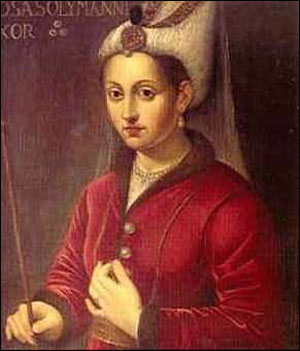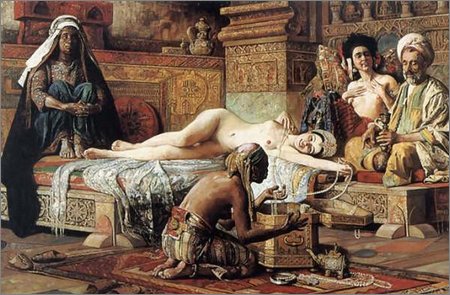 (Note: Be careful when you Google her name. Nothing bad, but there is a Kosen Sultan who appears to hold the Guinness record for being the world’s tallest man, so not to be confused.)
(Note: Be careful when you Google her name. Nothing bad, but there is a Kosen Sultan who appears to hold the Guinness record for being the world’s tallest man, so not to be confused.)
So the “harem” is one of my favorite not-favorite Orientalist tropes. (“Favorite not-favorite” is one of my favorite phrases.) It’s also a very misunderstood concept, heavily romanticized in Western art and literature and imagined as a sexually debauched space where scantily clad women lounge on divans smoking hookah and pleasuring, well, pretty much any dude who walks in the door. You can see why it’s been popular.
In reality, the harem was an enclosed space for the women of the royal household, etymologically derived from the Arabic haram—forbidden—which allowed elite women to live in seclusion and yet still have access to and even exert control over the seat of power. In the Ottoman Empire, the women of the harem could be very influential, even enjoying a period in the 16th and 17th centuries known as the “Sultanate of Women” when, through regencies and political strategizing, they were practically in charge. It’s worth noting that this partly coincided with the height of the Empire’s power.
Kösem Sultan is one of the most extraordinary of these women. Born on a small Greek island around 1585, she eventually made her way to Constantinople at age fifteen, sold into the harem of the Ottoman Sultan Ahmed I, where she became a favorite of his and then became one of his wives.
Ahmed died in 1617, and in 1623 Kösem’s son Murad IV became Sultan and Kösem became Valide Sultan, or Mother of the Sultan. Because Murad was a minor, Kösem was his official regent—the first woman to ever rule the Ottoman Empire and one of only two who ever would. She was regent for nine years.
Now, as I hinted at earlier, the Ottoman Empire in this period was nothing to sneeze at. Its subjects numbered around thirty million, and its reach extended across North Africa, Eastern Europe, and most of what we now know as the Middle East. Like many empires, it could have probably quit while it was ahead circa 1550, but continued to expand and was mostly still doing A-OK until 1683, when the Ottomans whiffed at the disastrous siege of Vienna, undertaken by Grand Vizier Kara Mustafa Pasha.
So Murad finally came of age, did alright, then died eight years later. Kösem’s other son, Ibrahim I, took the throne, but dude was kind of a mess (random headaches, bouts of physical weakness, mental instability) and Kösem was basically the power behind the throne. Then Ibrahim was deposed and Kösem craftily presented her seven-year-old grandson, Mehmed IV, as the new sultan, and thus became regent for Time No. 2.
This second bout of imperial power was only to last three years, however, before she was challenged by her daughter-in-law Turhan Hatice, mother of Mehmed and another major harem imperial power player. Turhan heard rumors that Kösem was plotting to remove Mehmed from the throne and replace him with another grandson—not one of Turhan’s—and it’s likely that it was Turhan who ordered Kösem’s assassination. Legend has it she was murdered by a eunuch, who strangled her with her own hair. Yikes.
Thus ended the tumultuous, Showtime miniseries-style life of Kösem Sultan. I would actually endorse the making of such a miniseries if I didn’t feel like it would be an Orientalist mess waiting to happen.
Kösem Sultan’s story is entertaining, and her bids for power are impressive, but not so great is the implication that women basically had two options in the Ottoman Empire: to be invisible, or to be a conniving power-hungry b-word. It’s a false dichotomy, but it’s how historical women tend to be remembered. She may very well have been these things, but let’s take into account the falsehoods of historical memory and the persistence of exaggerated feminine tropes, not to mention the potential Orientalization of otherwise straightforward political history (a eunuch? strangled with her own hair? it's almost too perfect), and instead celebrate(?) the awesome ambition of Kösem, the sultan-iest of Ottoman royal women.


